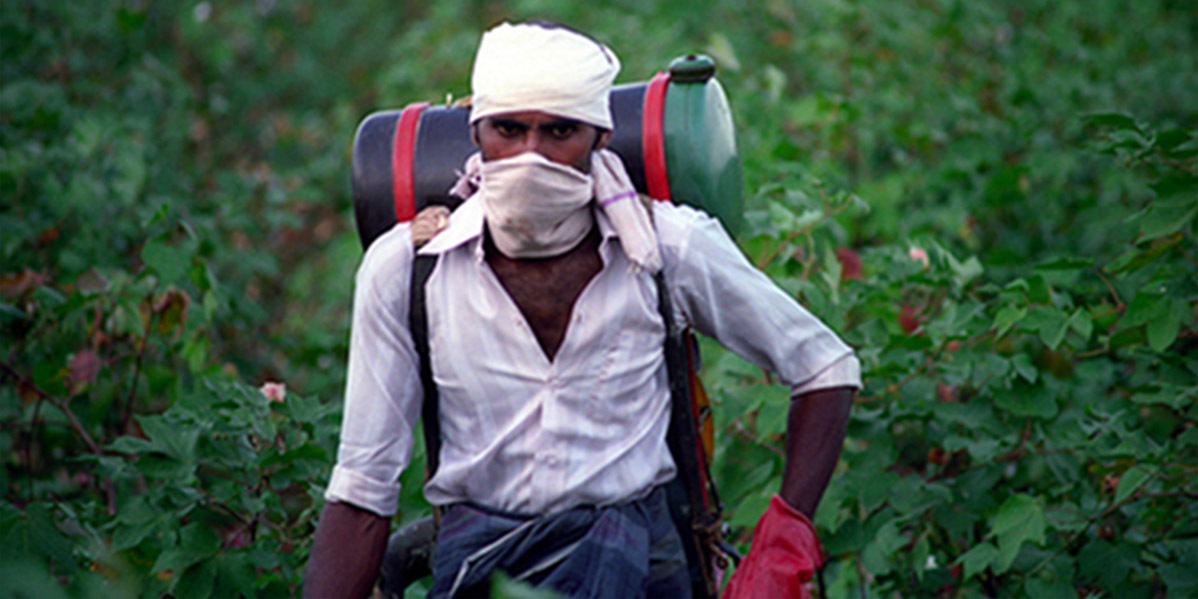
Pest attacks have led to heavy spraying of pesticides, which have poisoned and killed at least 40 farmers
Reports have emerged from Maharashtra of a sudden surge in pink bollworm and other pest attacks on GM Bt cotton crops.
Kishore Tiwari, chairman of the state-run task force on farm distress, said, “Anxious farmers, who manually opened the bolls, were aghast to see pink bollworms in abundance. The situation is unprecedented and it looks like more than 50% of the standing crop has been lost to [boll]worms that should not have attacked the genetically modified crop at all.”
“In some fields there is total damage. I have reports of farmers flattening the [GM Bt] cotton crop using tractors as there was little hope of salvaging yield.”
Pesticide-poisoned farmers
The pest attacks on GM Bt cotton have led to "indiscriminate spraying of pesticides and, consequently, possible poisoning deaths" of farmers, according to an article in the Indian press.
The article mentions the "widespread reports of Bt cotton falling prey to the pink bollworm" even though "Bt cotton is supposed to be resistant to this pest".
It reports farm distress expert Tiwari as saying that sucking pests such as the mealy bug and the pink bollworm have damaged vast tracts of cotton across Maharashtra. This has necessitated more spraying of pesticides, with devastating consequences for people in the region.
Since August this year, according to the article, pesticide poisoning has killed at least 40 people, mostly labourers across the six districts of Vidarbha, with Yavatmal alone accounting for at least 22 deaths and over 800 people affected.
Another article notes that Tiwari said he had cautioned the government at the end of August about likelihood of pink bollworm attack as the pests had become resistant to the Bt crop. In May, the then Maharashtra government had written to India's central government on the need to review approval given to the Bt cotton.
But it seems that the central government ignored the state government's warnings and failed to conduct any review.
Mark Lynas hyped GM Bt cotton
The pesticide poisoning tragedy highlights the culpability of GMO proponents like Mark Lynas, who earlier this year hyped GM Bt cotton on the basis of his claim that in India and China, "farmers have benefitted via reductions in pesticides".
Lynas's groundless enthusiasm for this GM crop is not shared by an expert who investigated the causes of the farmer pesticide poisonings. Dr D. Narasimha Reddy is director of Pesticide Action Network (PAN) India and head of a team that looked into the tragedy in Yavatmal district. Dr Reddy urged the Indian government to rethink its policy of adopting GM seeds, saying “This tragedy validates previous findings that GM seeds, like Bt cotton, will not reduce pesticide use but rather intensify it. Neither will GM seeds address poverty as the victims of poisonings could now attest.”
Indian govt fails to regulate pesticides
In its report on the pesticide poisonings, the PAN India team uncovered failures in governance and regulation. For example, they found that the victims sprayed the pesticides monocrotophos, diafenthiuron, profenofos and fipronil, with no or minimal protective gear. All these have been classified as highly hazardous pesticides (HHPs) for being carcinogenic, endocrine disruptors and/or neurotoxic.
Dr Reddy said, “The farmers wanted to save their Bt cottons from massive pest attacks that they resorted to the use of pesticides. Yet how would the farmers know the hazards of these pesticides when the label information is not in their language?
“Almost all of the surviving victims had never used personal protective equipment. They complained of eye irritation, and burning sensation on the eyes and face. One victim said that the pesticide spray fell back to his face several times due to the wind direction, and attributed such mishap to the overgrown Bt cotton that reached nearly six feet."
PAN India says the increase in height of Bt cotton could be due to monocrotophos, which the farmers used after the Bt cotton’s resistance to pests weakened. Nagpur-based Central Institute of Cotton Research (CICR) said that this insecticide stimulates growth and has a greening effect on plants.
Monocrotophos is banned in 60 countries and is in the Rotterdam Convention Prior Informed Procedure List (PIC) and the PAN’s Terrible Twenty (T20) pesticides. It was implicated in the "midday meal tragedy" in which 27 schoolchildren in Bihar died of pesticide poisoning after eating a contaminated midday meal. The two other HHPs – diafenthiuron and profenos – are banned in 29 countries, while fipronil is banned in eight countries.
Deeppa Ravindran, PANAP Pesticides Programme coordinator, was not surprised by India's latest pesticide poisoning tragedy. He said, “India’s unregulated use of highly hazardous pesticides can be likened to a ticking time bomb. Time and again, PANAP and its partners have called on the Indian government to ban these chemicals especially since the use of personal protective equipment in hot and humid countries is unmanageable if not outright unbearable for the users.”










